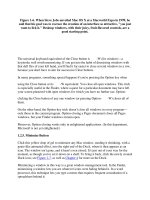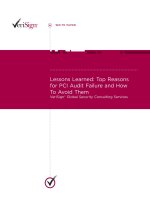calverley - bubbles and how to survive them (2004)
Bạn đang xem bản rút gọn của tài liệu. Xem và tải ngay bản đầy đủ của tài liệu tại đây (3.49 MB, 235 trang )
PRAISE FOR
BUBBLES
AND HOW TO SURVIVE THEM
“Financial bubbles have always exercised a fascination over academics
and financial journalists. Business economists can make their
reputation by spotting them in time. But in truth relatively little is
known about what generates bubbles, what causes the eventual bust,
what damage bubbles can do, and how they can be prevented. Most
importantly, are we in one now?
In this book, John Calverley explores this subject in considerable depth,
using an analytic approach but writing in a style accessible to the inter-
ested layman. Calverley is the Chief Economist of American Express
bank, so he knows what he is talking about. He belongs to the school
that believes bubbles are recognisable, dangerous and preventable. More-
over, he thinks the housing market in Britain and some other countries
now displays the characteristics of a bubble. He has a number of policy
recommendations, many of which will prove controversial.
Not everyone will agree with all aspects of his diagnosis or
prescription. But it is hard to dispute that this book addresses an
important and so far poorly understood topic.”
Sir Andrew Crockett, President, J. P. Morgan Chase International
and former General Manager, Bank of International Settlements,
1999–2003
“This is a must read for anyone considering investing in housing or
stocks as well as market practitioners wishing to glean insights into
how the herd can behave.”
Gerry Celaya, Chief Strategist, Redtower Research
“This is an indispensable book for everyone, investors and students
alike, who wants to understand how bubbles arise—and to avoid
being caught out by the next one.”
Roger Bootle, Capital Economics
Bubbles Prelims 6/8/04 7:55 PM Page i
“This book offers a timely warning. Around the world real estate
prices have been rising strongly as home-buyers take advantage of low
mortgage rates. But if home price increases turn out to be a bubble,
the consequences for many recent buyers as well as for the economy
as a whole could be severe.”
Ranga Chand, economist and expert on mutual funds, Toronto
“There is no more controversial question that what to do about the
housing bubble, whether you are a buyer, a seller, a renter or a
central bank governor. John Calverley has compiled a primer for all,
tackling the many difficult questions logically and informatively. He is
to be commended for making some very constructive proposals for
what looks like a problematic future.”
Alex Erskine, Managing Director of Erskinomics Consulting, Vis-
iting Fellow with Macquarie Applied Finance Centre, Sydney and
former head of Asian research for a leading global bank
“A clearly written analysis that deftly uses statistical data to reveal the
nature of bubble/bust cycles and offers insights on how to deal with
them.”
Tadashi Nakamae, Nakamae International Economic Research
“Calverley has written a book for our times: when growth is fuelled
by asset bubbles and central bankers held hostage by the fear of their
collapse. He brings a global view and the lessons of economic history
to diagnose the problem, to develop new ideas for policy makers and
to provide sound advice for investors.”
Dr. DeAnne Julius CBE
“If you are worried about your future, read this book with care. If
you’re not, read and take heed. This is high quality, X rated stuff, not
for the faint-hearted, written with great clarity and balance.
Essential reading on any public financial education course.”
Richard O’Brien, Partner, Outsights
Bubbles Prelims 6/8/04 7:55 PM Page ii
BUBBLES
AND HOW TO
SURVIVE THEM
Bubbles Prelims 6/8/04 7:55 PM Page iii
The data, facts and examples used in this text are believed to be
correct at the time of publication but their accuracy and reliability
cannot be guaranteed. Although the author expresses a view on the
likely future investment performance of certain investment
instruments, this should not be taken as an incitement or a
recommendation to deal in any of them, nor is it to be regarded as
investment advice or as a financial promotion or advertisement.
Individuals should consider their investment position in relation to
their own circumstances with the benefit of professional advice. No
responsibility is assumed by the author or the publisher or American
Express Bank Ltd. for investment or any other decisions taken on the
basis of views expressed in this book.
American Express Bank Ltd., 60 Buckingham Palace Road,
London, SW1W 0RR (No. FC 1863, BR301).
Incorporated with limited liability in the State of Connecticut, USA
and registered with the Secretary of State, Hartford, Connecticut, USA
with its head office in New York, USA.
Bubbles Prelims 6/8/04 7:55 PM Page iv
BUBBLES
AND HOW TO
SURVIVE THEM
John Calverley
N ICHOLAS B REALEY
P UBLISHING
LONDON BOSTON
Bubbles Prelims 6/8/04 7:55 PM Page v
First published by
Nicholas Brealey Publishing in 2004
3–5 Spafield Street 100 City Hall Plaza, Suite 501
Clerkenwell, London Boston
EC1R 4QB, UK MA 02108, USA
Tel: +44 (0)20 7239 0360 Tel: (888) BREALEY
Fax: +44 (0)20 7239 0370 Fax: (617) 523 3708
© American Express Bank 2004
The right of John Calverley to be identified as the author of this work
has been asserted in accordance with the Copyright, Designs and
Patents Act 1988.
ISBN 1-85788-348-9
British Library Cataloguing in Publication Data
A catalogue record for this book is available from the
British Library.
All rights reserved. No part of this publication may be reproduced,
stored in a retrieval system, or transmitted, in any form or by any
means, electronic, mechanical, photocopying, recording and/or
otherwise without the prior written permission of the publishers.
This book may not be lent, resold, hired out or otherwise disposed of
by way of trade in any form, binding or cover other than that in
which it is published, without the prior consent of the publishers.
Printed in Finland by WS Bookwell.
Bubbles Prelims 6/8/04 7:55 PM Page vi
CONTENTS
Foreword ix
Preface xi
Introduction: Why Bubbles Matter 1
PART I BUBBLE AND BUST 9
1 An Anatomy of Bubbles 11
2 The Great Depression 26
3 Japan and the Specter of Deflation 42
4 The Greenspan Bubble and Reflation 57
PART II HOUSING: THE NEXT CRASH? 71
5 The Worldwide Boom 73
6Britain Nears the Top 84
7A US Bubble? 97
8 Household Debt and Monetary Policy 107
PART III ORIGINS AND SOLUTIONS 121
9 The Pathology of Bubbles 123
10 Valuing Markets Sensibly 137
11 New Policy Approaches 159
12 Strategies for Investors 181
Final Thoughts: Living with Bubbles 195
Notes 203
Index 215
Bubbles Prelims 6/8/04 7:55 PM Page vii
Bubbles Prelims 6/8/04 7:55 PM Page viii
FOREWORD
There can hardly ever have been a more timely book than this. Asset
price volatility, and especially the movement of house prices, has
moved center stage in the economy. A central theme of the book is that
asset bubbles make the economy, and possibly the financial system,
potentially unstable. In this regard, John Calverley has addressed one of
the key issues and risks of the day and argues persuasively of the dan-
ger of a period of debt deflation and a serious risk that house prices
could fall sharply as a bubble in the market is burst. The combination
of record high levels of debt and a housing bubble also increases the
risk of monetary policy mistakes.
In a carefully chronicled tour de force, which is written in a wonder-
fully clear and engaging style, John Calverley has produced a powerful
insight into some of the many myths that surround this subject, and
most especially the housing market. The author gives us some fascinat-
ing insights from behavioral finance and in particular into how markets
can lose touch with reality.
Everyone has an interest in this subject and Calverley has produced
a book that can be easily read by both technicians in the subject and
the layperson. It deserves to be very widely read.
David T. Llewellyn
Professor of Money and Banking, Loughborough University
ix
Bubbles Prelims 6/8/04 7:55 PM Page ix
Bubbles Prelims 6/8/04 7:55 PM Page x
PREFACE
I
n recent years a series of bubbles and busts in the world’s stock and
property markets have become the main focus for both investors and
policy makers, overshadowing the much milder fluctuations in ordi-
nary consumer price inflation. Many investors lost heavily in the col-
lapse of the 1990s stock bubble, but now many people are betting on
continually rising house prices. Meanwhile, policy makers seem to have
no way to restrain bubbles; indeed, their adherence to orthodox poli-
cies may be making the problems worse.
This book looks at bubbles from two points of view: those of the
interested observer of the economy and the investor. In truth, most of
us are both. The performance of the economy matters to everyone,
through its impact on jobs and incomes. But the performance of asset
prices from an investment point of view is more important than ever,
for the value of our homes and for our security in retirement.
The US is the most critical arena, by virtue of its own importance
and because America’s economic health remains vital for the whole
world. Moreover, US monetary policy has played a central role in bub-
bles everywhere in the last two decades. However, Britain and Australia
are currently leading the way in the housing bubbles and I also draw
heavily on experiences in Japan and Hong Kong.
The Introduction sets out the key problem we face today. Federal
Reserve Chairman Alan Greenspan led the way in cutting interest rates
to contain the fallout from the 1990s stock market bubble, but at the
cost of inflating huge, and potentially even more dangerous, housing
bubbles. Policy makers now have to find a way to normalize interest
rates and maintain economic growth, without triggering either a col-
lapse in house prices and a new recession, or alternatively a return to
high inflation.
The first part of the book looks at how bubbles emerge and the
effects they have on the economy, both as they inflate and when they
Bubbles Prelims 6/8/04 7:55 PM Page xi
collapse. The 1920s stock market bubble, very similar in many ways to
the 1990s experience, is analyzed to see how and why we avoided dis-
aster this time, though the full consequences of the 1990s bubble are
still working through, with pensions in crisis and many investors retain-
ing unrealistic expectations for returns. Japan’s 1980s bubble and bust
are examined, with particular emphasis on the interaction with defla-
tion, a consequence of the bust but also a major impediment to
recovery.
Part II looks at the emerging housing bubbles around the world.
While the UK and Australia are extreme cases, US home prices are
already bubbling in some regions and, unless price increases slow, most
of the country will soon be affected. Household debt has risen rapidly
alongside housing bubbles and the implications for stability and for
monetary policy are explored.
Part III looks at the underlying origins of bubbles and offers some
solutions. Studies in the field of behavioral finance show how investors
sometimes lose touch with reality. If this is allied with policy mistakes
the combination can be lethal. The key issue of valuations is addressed:
Can we identify “reasonable” levels for markets, so that investors have
better warning of when bubbles are developing and policy makers can
consider countermeasures? And what countermeasures are available,
for example through monetary policy, public warnings, or “speed lim-
its” on bank lending? The last chapter looks at strategies for investors,
who must try to avoid bubbles or, more dangerously, seek to ride them.
Finally, I offer some thoughts on how the twin problems of housing
bubbles and rising debt will evolve. Much will depend on monetary
policy and whether central bankers can be astute enough, and perhaps
lucky enough, to find their way through. Major adjustments will be nec-
essary in the US economy and others. If the adjustments can be made
gradually and smoothly, the outcome will be fine. If they occur
abruptly, it could be a rough ride.
My interest in bubbles goes back to university days and I owe a great
debt to four teachers in particular: Michael Kuczynski, Hyman Minsky,
and David Felix, who always emphasized the role of financial market
instability, and Larry Meyer, who placed the emphasis on intelligent
policy making to deal with crises. As a practicing economist and strate-
Bubbles and How to Survive Them
xii
Bubbles Prelims 6/8/04 7:55 PM Page xii
gist in the 1980s, my interest was kindled with the 1987 stock market
crash, the subsequent bubbles in housing, and, most of all, the bubble
and bust in Japan. When the US stock market took off again in the sec-
ond half of the 1990s and the Asian bubble collapsed, I resolved to
write this book. It has taken a long time and the stock bubble has been
replaced by housing bubbles—but the issue is more relevant than ever.
ACKNOWLEDGMENTS
I am enormously grateful for comments and suggestions from Kate
Barker, Roger Bootle, Claudio Borio, Gerry Celaya, Alex Erskine, Jan
Hatzius, DeAnne Julius, Richard O’Brien, Mark Tapley, David Walton,
and Sushil Wadwani. Also to many colleagues at American Express,
including Bob Friedman, Kevin Grice, Sarah Hewin, Dan Laufenburg,
Gordon Townsend, Chris Wang, and Meiping Yang. Sharon Thornton
and Maria Whittaker have helped with tables and charts.
I also want to thank Nicholas Brealey. Never before have I experi-
enced such an active publisher. His suggestions, while often challeng-
ing, have always been stimulating and have made the book much more
readable than if I had been left to my own devices!
Finally, I would like to thank American Express Bank for encourag-
ing me to write this book. However, the views expressed herein are
entirely those of the author and are not necessarily those of American
Express Bank Ltd. or its affiliates.
Preface
xiii
Bubbles Prelims 6/8/04 7:55 PM Page xiii
Bubbles Prelims 6/8/04 7:55 PM Page xiv
INTRODUCTION:
WHY BUBBLES MATTER
M
ost people have heard of the Tulip Mania (Holland, 1630s), the
South Sea Bubble (London, 1720), and the Wall Street Crash
(the US, 1929). Less well known are the emerging market min-
ing mania (London and South America, 1820s) and the railway mania
(UK 1840s), and there were many more in the eighteenth and nineteenth
centuries.
1
These were all bubbles: a huge rise in prices followed by a crash.
In the middle decades of the twentieth century there was a lull,
when bubbles were few and far between. But in the last 20–30 years
bubbles have returned in a big way. In the last quarter of a century we
have had the Japanese bubble (1980s), the UK and Scandinavian hous-
ing bubbles (late 1980s), the Asian Tigers bubble (mid-1990s), and the
technology mania (late 1990s). Not only are they giving investors a
roller-coaster ride, they are also having a major impact on the economy.
In each case the story begins with a rise in prices in the market in
question, often for a good reason, which then continues on upward to
an extraordinary level of valuation, before crashing back. On the way
up the rise in price encourages a high level of business investment,
boosting economic growth and prosperity and often creating a sense of
euphoria. Following the crash the economy is hit by a combination of
reduced wealth, financial caution, and uncertainty. At best this brings
only an economic slowdown or a mild recession. At worst it can create
a major depression, as in the US in the 1930s or Japan in the 1990s.
That such patterns repeat is a source of wonder to many. Does this
mean people have short memories? Does it mean they are irrational? Is
there a flaw in the financial system that encourages speculation?
Kindleberger, in his classic 1978 book on the subject, was forced to
argue at some length why contemporary commentators, who argued
that the world had changed and bubbles had become less likely, would
1
Bubbles Intro 6/8/04 7:55 PM Page 1
be proved wrong.
2
He was writing in a period when the world had been
relatively free of major manias and crashes for a while. Now, with the
collapse of the 1990s stock market bubble still reverberating and amid
signs that housing bubbles are emerging, the old patterns have
returned with a vengeance.
Earlier systems of economic organization, such as feudalism,
nineteenth-century capitalism, or socialism, involved a sharp concen-
tration of economic wealth and power in the hands of a few land-
owners, a small group of capitalists, or an elite group of bureaucrats.
Today, ownership of assets is much more widespread. Even 50 years ago
only a very small proportion of the population held any assets other
than small-scale deposits. Now more than 75 percent of the population
in developed countries own stocks, mutual funds, houses, or pensions.
It is also much easier to trade assets than before. The immediate
transparency of prices on electronic quotation systems is now accessi-
ble to all through the internet, whereas just a few years ago it was avail-
able only to the big financial institutions. Even the purchase of
property, still a relatively illiquid asset, has become easier, with the
internet reducing search costs and mortgages more readily available.
The new asset-backed economy creates a far wider dispersion of
wealth and represents a genuine democratization. But it also brings
volatility, which can be very damaging to the economy as well as
creating crippling losses for investors.
TWENTIETH-CENTURY BUBBLES
The most disastrous bubble ever seen was the 1920s US stock bubble.
After it burst in the Wall Street Crash of 1929, the effects of the asset
price collapse, combined with central bank and government policy
mistakes in 1931–2, plunged the world into a severe depression. The
resulting political turmoil, particularly in Germany and Japan, com-
bined with trade protectionism to lead ultimately to the Second World
War.
The worst episode in recent times has been in Japan following the
collapse of its stock and property bubbles. From the peak in 1991, land
Bubbles and How to Survive Them
2
Bubbles Intro 6/8/04 7:55 PM Page 2
prices fell more than 90 percent while stock prices slumped 80 percent.
The 1990s was a “lost decade” for Japan, with economic growth averag-
ing less than 1 percent a year and unemployment rising sharply. Inter-
est rates were cut too slowly to kick-start the economy and attempts to
use active fiscal policy led to an explosion of government debt. And,
though the government has avoided a banking crisis, it has yet to deal
fully with the overhang of bad debt left from the bubble years. Hopes
are high that the economy is at last making a genuine recovery,
although it has been a very long time coming.
In 1997–8 the Asian Tigers suffered a similar crisis, after asset price
bubbles collapsed. While the trigger was a currency collapse, it was the
massive rise and subsequent fall of property and stock prices that made
the aftermath so painful. Only a few years earlier, as the bubbles
inflated, these countries had been enjoying what was widely regarded
as the “Asian miracle.”
Today we are living with the aftermath of the 1990s stock bubble,
fostered by technology and growth stocks. In the late 1990s US policy
makers, led by Federal Reserve Chairman Alan Greenspan, sat back
and watched as the US stock market went into a bubble strikingly
similar to the 1920s experience. They argued that it was not neces-
sarily a bubble and that, even if it were, it would be dangerous to
deflate and much better to wait and be ready to deal with any bust
after the event.
Whether allowing a bubble to inflate unchecked is really the best
approach remains a controversial question, examined carefully in the
pages that follow. What is clear, though, is that having learned the
lessons from the 1930s and also the 1990s Japan experience, the US
authorities have been determined to prevent the asset price bust lead-
ing to a major economic slump and deflation. So far at least they have
succeeded, with the help of rapid and deep cuts in interest rates and a
huge fiscal stimulus. The US did suffer a recession in 2001 but it was
only comparatively mild. And the economic recovery picked up steam
in 2003–4, so that fears of deflation have receded. Nevertheless, reactive
policy is creating new difficulties for the future.
Introduction: Why Bubbles Matter
3
Bubbles Intro 6/8/04 7:55 PM Page 3
BUDGET DEFICITS
The budget stimulus instigated by President Bush, including major
tax cuts and increased military spending, was the largest fiscal stimu-
lus in American history. But the legacy is a budget deficit of more
than 5 percent of GDP, a level that creates problems of its own for the
long term. European countries have also used active fiscal policy in
recent years, particularly the UK but to a lesser extent Germany and
France as well, and deficits are now running in the 3–4 percent of
GDP range, again too high.
High deficits drag on economic growth, by reducing the resources
available to the private sector and raising real interest rates. They also
threaten rising government debt ratios, which can eventually make
debt unsustainable. Japan already faces this problem with its debt ratio
at over 160 percent of GDP. The US and Europe still have ratios closer
to 60 percent (the UK at only 40 percent), so their problem is less
urgent. However, this is not the whole story because governments have
additional liabilities that are not included in official debt data, the
most important being pensions and health care.
So far the US has avoided the drag from its budget deficit with the
help of a matching current account deficit. In effect, foreigners are
financing the budget deficit by sending the money gained from their
trade surpluses with the US straight back into the US economy. During
2003–4 Asian central banks were the main sources of finance, buying
US dollars to prevent their currencies appreciating too much so that
they could maintain their own economic expansion.
Nevertheless, this large current account deficit also has long-term
consequences for the US, in the build-up of foreign liabilities. At some
point the current account deficit will need to be corrected and this
will imply a prolonged period of dollar weakness. A weak dollar will
help the US economy if the problem then is maintaining growth, but
is a threat if inflation should start to pick up again. This will depend
on whether or not the US has spare resources in the economy at the
time.
High budget deficits have another important consequence. If we face
a new economic slump, governments will have used up their fiscal
ammunition. Japan reached this point in the mid-1990s, five years after
Bubbles and How to Survive Them
4
Bubbles Intro 6/8/04 7:55 PM Page 4
the bust began, but the US and Europe got there in just two years. In
the US the authorities used up virtually all their monetary policy
ammunition too, taking interest rates down to 1 percent. Provided that
the current economic recovery continues, rates will rise in the next few
years but, in a world of low inflation, will remain relatively low. There
are other monetary measures that can be taken if rates hit the zero
limit, but these are untried and untested.
The US stimulus succeeded in averting an economic disaster in
2002–3 partly because of its sheer size and speed of implementation,
but also because of a crucial difference between the 1990s bubble and
Japan’s experience. Japan’s bubble was not only in stocks but in prop-
erty too. When property prices fell in the 1990s the effect was to under-
mine Japanese companies’ balance sheets and leave banks with huge
losses.
In contrast, property prices in the US and Europe held up fairly well
after the stock market bust. Commercial property prices were relatively
restrained in the 1990s and when economic growth slowed in 2001
there was only a limited overhang of supply, so rents and prices were
only moderately affected. But—and this is critical—residential house
prices not only have not fallen but, most unusually during an eco-
nomic downturn, have risen sharply.
By cutting interest rates so dramatically, there is a danger that cen-
tral banks have shifted the bubble from stocks to residential property.
I shall argue that, with valuations at historically high levels, we face
housing bubbles now in the UK, Australia, Spain, and the Netherlands.
Worryingly for everyone, a bubble may be emerging in the US as well.
If these bubbles give way to busts there is a risk that the next recession
will be severe, especially since the evidence suggests that property price
declines have more impact on the economy than stock price falls. More-
over, with inflation so low, there is a danger that a new recession in the
next few years could see more countries following Japan into a defla-
tionary scenario. While deflation is not always bad news, it is some-
thing to fear if asset prices are falling too and debt is high. With
household debt at record levels in all these countries, the potential for
serious problems is considerable.
Introduction: Why Bubbles Matter
5
Bubbles Intro 6/8/04 7:55 PM Page 5
WHY BUBBLES MATTER
When any bubble goes bust, some people lose. Experienced speculators
can be caught out, though they sometimes recognize the end of a bub-
ble and cut their positions in time. Most importantly, they usually
know how to limit their risk to a bearable level. The investors who
really suffer are those who are drawn in, often at the late stages of a bub-
ble, with very little experience of how to manage risks.
For a bubble to continue to inflate it needs more and more people
to invest, risking more and more money. The end of the bubble occurs
either because there is nobody left to be drawn in, or because some
event makes people start to sell.
If bubbles affected only a few investors, with little impact on the
overall economy, they would be of limited importance. Some bubbles
are indeed like that. The bubble in classic car prices in the late 1980s,
for example, had only minor repercussions. A few people made a lot of
money on the way up and some lost when prices crashed at the end of
the decade, but the numbers involved were small. Obviously classic cars
cannot be newly manufactured so, although there were some new deal-
ers who set up during the bubble and then closed after the bust, the
wasted resources involved were small. The bubble in impressionist
paintings at the same time had a similarly limited effect, as did bubbles
in silver and gold prices in the 1970s.
However, bubbles can cause major problems when they occur in an
asset that is widely held. Then, not only do a large number of people suf-
fer directly when the bubble bursts, as the bubble inflates it also inter-
acts with the economy, creating a self-reinforcing boom and bust. The
dangerous bubbles, therefore, are usually the ones in stocks and property.
POLICY DILEMMAS
So what can be done? Can we find ways to prevent bubbles inflating?
Are there clear warning signs, from valuations or other factors? Should
we look for ways to restrain bank lending when prices become too
much out of line? And how can investors protect themselves?
Bubbles and How to Survive Them
6
Bubbles Intro 6/8/04 7:55 PM Page 6
These are the issues that will be discussed in Part III of this book.
First, we need to take a look at the origins and effects of previous bub-
bles in Part I, and particularly at the problem of housing bubbles in
Part II.
Introduction: Why Bubbles Matter
7
Bubbles Intro 6/8/04 7:55 PM Page 7
Bubbles Intro 6/8/04 7:55 PM Page 8
PART I
BUBBLE AND BUST
Bubbles Chapter 01 6/8/04 7:55 PM Page 9
Bubbles Chapter 01 6/8/04 7:55 PM Page 10









